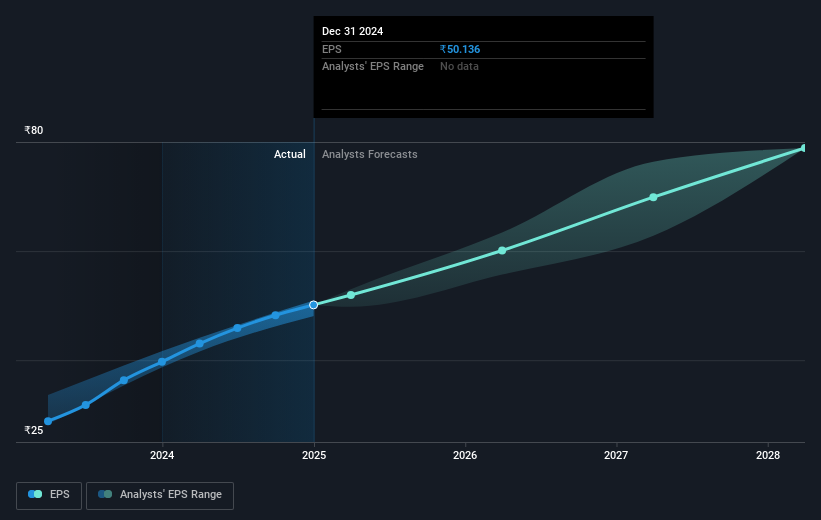- India
- /
- Healthcare Services
- /
- NSEI:LALPATHLAB
Dr. Lal PathLabs' (NSE:LALPATHLAB) five-year earnings growth trails the 12% YoY shareholder returns

While Dr. Lal PathLabs Limited (NSE:LALPATHLAB) shareholders are probably generally happy, the stock hasn't had particularly good run recently, with the share price falling 15% in the last quarter. But the silver lining is the stock is up over five years. Unfortunately its return of 69% is below the market return of 205%.
Since it's been a strong week for Dr. Lal PathLabs shareholders, let's have a look at trend of the longer term fundamentals.
To quote Buffett, 'Ships will sail around the world but the Flat Earth Society will flourish. There will continue to be wide discrepancies between price and value in the marketplace...' By comparing earnings per share (EPS) and share price changes over time, we can get a feel for how investor attitudes to a company have morphed over time.
During five years of share price growth, Dr. Lal PathLabs achieved compound earnings per share (EPS) growth of 11% per year. That makes the EPS growth particularly close to the yearly share price growth of 11%. That suggests that the market sentiment around the company hasn't changed much over that time. Rather, the share price has approximately tracked EPS growth.
The graphic below depicts how EPS has changed over time (unveil the exact values by clicking on the image).

We know that Dr. Lal PathLabs has improved its bottom line lately, but is it going to grow revenue? You could check out this free report showing analyst revenue forecasts .
What About Dividends?
When looking at investment returns, it is important to consider the difference between total shareholder return (TSR) and share price return. Whereas the share price return only reflects the change in the share price, the TSR includes the value of dividends (assuming they were reinvested) and the benefit of any discounted capital raising or spin-off. Arguably, the TSR gives a more comprehensive picture of the return generated by a stock. As it happens, Dr. Lal PathLabs' TSR for the last 5 years was 75%, which exceeds the share price return mentioned earlier. The dividends paid by the company have thusly boosted the total shareholder return.
A Different Perspective
It's good to see that Dr. Lal PathLabs has rewarded shareholders with a total shareholder return of 12% in the last twelve months. And that does include the dividend. Having said that, the five-year TSR of 12% a year, is even better. I find it very interesting to look at share price over the long term as a proxy for business performance. But to truly gain insight, we need to consider other information, too. Case in point: We've spotted 2 warning signs for Dr. Lal PathLabs you should be aware of.
Of course Dr. Lal PathLabs may not be the best stock to buy. So you may wish to see this free collection of growth stocks.
Please note, the market returns quoted in this article reflect the market weighted average returns of stocks that currently trade on Indian exchanges.
New: Manage All Your Stock Portfolios in One Place
We've created the ultimate portfolio companion for stock investors, and it's free.
• Connect an unlimited number of Portfolios and see your total in one currency
• Be alerted to new Warning Signs or Risks via email or mobile
• Track the Fair Value of your stocks
Have feedback on this article? Concerned about the content? Get in touch with us directly. Alternatively, email editorial-team (at) simplywallst.com.
This article by Simply Wall St is general in nature. We provide commentary based on historical data and analyst forecasts only using an unbiased methodology and our articles are not intended to be financial advice. It does not constitute a recommendation to buy or sell any stock, and does not take account of your objectives, or your financial situation. We aim to bring you long-term focused analysis driven by fundamental data. Note that our analysis may not factor in the latest price-sensitive company announcements or qualitative material. Simply Wall St has no position in any stocks mentioned.
About NSEI:LALPATHLAB
Dr. Lal PathLabs
Operates laboratories for carrying out pathological investigations in India and internationally.
Outstanding track record with flawless balance sheet.
Market Insights
Community Narratives



